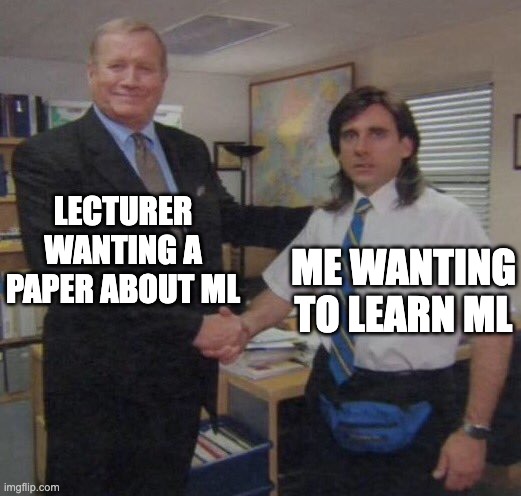How to land a data science job without a relevant degree?
Many people were surprised when I told them I graduated with only a Bachelor’s in Mechanical Engineering, and I became a data scientist without a relevant degree in the field of IT or Statistics. This inspired me to write a step-by-step guide for aspiring data scientists with a completely different educational background.

Step 1: Understand your passion
First and foremost, ask yourself: Which part of data science sets your soul on fire? Is it creating beautiful visualisations, identifying interesting trends in data, or building state-of-the-art neural network models? Finding a specific skill or topic that makes you passionate is very important - it motivates you to take the extra mile, to take time after work or studies to master this skill. For me, it was neural networks and deep learning, which I stumbled upon during my third year of university. The idea that a bunch of neurons could predict a result accurately with pure algebra and differential calculus (and tons of data) absolutely fascinated me. Since then, I never looked back.
Step 2: Self-learning
Once you know where your passion lies, commit yourself to learn it! Don’t worry if you don’t have any programming experience - I had none when I started. Here is a non-exhaustive list of free resources that I studied to up-skill myself, in no particular order:
- Python
- SQL
- Statistics and Mathematics
- Fundamentals of Machine Learning - Andrew Ng’s YouTube videos. Don’t worry if you don’t understand.
- Neural Networks in PyTorch - sentdex’s Youtube videos
- AB Testing
- AWS
- Data Visualization - Tableau’s free 14 days trial
When I was learning machine learning and neural network, I remember pausing at every second of the video just to copy and execute a new line of code, even though I didn’t know what it does. But after copying the same code 5 times, on 5 separate occasions - it started to make more sense. So, practice makes perfect!
It is important to note that at this stage, you don’t have to learn all the skills from data engineering, machine learning to visualisations. Just focus on mastering the skill that you’re most passionate about, and be a pro at it! For instance, if your goal is to understand AB testing, you can skip the machine learning and deep learning bits and dive straight into Python and SQL (useful for data extraction).
Step 3: Real-life Projects
Once you’ve done the tutorials and feel more confident, level up your data skills by contributing to university societies, grassroots organisations, and open-source projects. My first real-life data science experience was during my university days when I joined a student-led entrepreneurial society called Enactus. As a volunteer for one of their tech projects, I cleaned and preprocessed data from a retail fashion website to become training data for a clothes classification model. Through this experience, I came to the conclusion that machine learning = 80% data engineering, preprocessing (boring, but important stuff) + 20% model development (the sexy stuff for most data scientists).

If you are a university student, and you are required to complete a thesis or capstone project for your degree, find a topic that involves data analysis or machine learning. For instance, if you are a commerce student, you could potentially use machine learning to predict the performance of a company or a GDP of a country. I was fortunate enough to find a lecturer who was seeking mechanical engineering students to implement neural networks for their honours thesis. After researching for a year, I had a deeper understanding of the nuts and bolts of neural networks. I developed a novel neural network to classify different coronary arteries in a patient, which will be in my next post.
If none of the above interests you, work on a passion project! 2 years ago, my friend and I were searching for a project, thus we started offering free data science and A.I. service on Facebook groups and tech community forums, and was even mocked in a forum due to lack of credentials. Things took a turn when fisheries startup approached us, and we eventually developed a fish recognition and counting POC for them using pre-trained YOLOv5 and Detectron models. More on that another day.
You don’t have to be involved in 10 different projects to prove your mettle, just focus on 2-3 projects, and be great at them! I landed my first data science job by mentioning 3 real-life projects in my CV, as stated above.
Step 4: Write a blog (optional)
With a wealth of data science projects under your belt, what other way to showcase your talent other than blogging? Here are 4 reasons why you should start blogging as an aspiring data scientist.
Step 5: Network, network, network!
Want to accelerate your job-seeking process? Join in-person or online tech meet-ups or summits. It’s literally striking 2 birds with one stone - you not only gain extra knowledge but also meet new people that could potentially refer you to their company. I think in the post-covid era, turnout has generally been low, but this also means that you could forge a closer connection with the fewer participants.
If you are seeking for in-person tech community events and are based in Sydney or Melbourne, shoot me a message and I’ll recommend you to some.
Conclusion
If you follow the aforementioned steps, you will be getting a data science offer in no time, considering how hot the tech market is. Wishing you all the best in your data science journey!


Comments